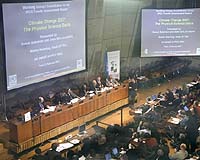| . |  |
. |
Manoa HI (SPX) Mar 02, 2010 Climate models project that the global average temperature will rise about 1C by the middle of the century, if we continue with business as usual and emit greenhouse gases as we have been. The global average, though, does not tell us anything about what will happen to regional climates, for example rainfall in the western United States or in paradisical islands like Hawai'i. Analyzing global model warming projections in models used by the Intergovernmental Panel on Climate Change, a team of scientists headed by meteorologist Shang-Ping Xie at the University of Hawaii at Manoa's International Pacific Research Center, finds that ocean temperature patterns in the tropics and subtropics will change in ways that will lead to significant changes in rainfall patterns. The study will be published in the Journal of Climate this month, breaking ground on such regional climate forecasts. Scientists have mostly assumed that the surfaces of Earth's oceans will warm rather evenly in the tropics. This assumption has led to "wetter-gets-wetter" and "drier-gets-drier" regional rainfall projections. Xie's team has gathered evidence that, although ocean surface temperatures can be expected to increase mostly everywhere by the middle of the century, the increase may differ by up to 1.5C depending upon the region. "Compared to the mean projected rise of 1C, such differences are fairly large and can have a pronounced impact on tropical and subtropical climate by altering atmospheric heating patterns and therefore rainfall," explains Xie. "Our results broadly indicate that regions of peak sea surface temperature will get wetter, and those relatively cool will get drier." Two patterns stand out. First, the maximum temperature rise in the Pacific is along a broad band at the equator. Already today the equatorial Pacific sets the rhythm of a global climate oscillation as shown by the world-wide impact of El Nino. This broad band of peak temperature on the equator changes the atmospheric heating in the models. By anchoring a rainband similar to that during an El Nino, it influences climate around the world through atmospheric teleconnections. A second ocean warming pattern with major impact on rainfall noted by Xie and his colleagues occurs in the Indian Ocean and would affect the lives of billions of people. Overlayed on Indian Ocean warming for part of the year is what scientists call the Indian Ocean Dipole that occasionally occurs today once every decade or so. Thus, the models show that warming in the western Indian Ocean is amplified, reaching 1.5C, while the eastern Indian Ocean it is dampened to around 0.5C. "Should this pattern come about," Xie predicts, "it can be expected to dramatically shift rainfall over eastern Africa, India, and Southeast Asia. Droughts could then beset Indonesia and Australia, whereas regions of India and regions of Africa bordering the Arabian Sea could get more rain than today." Patterns of sea surface temperature warming and precipitation change in 2050 as compared with 2000. Annual mean precipitation change is shown in green/gray shade and white contours in mm/month. Precipitation tends to increase over regions with ocean warming above the tropical mean (contours of warm colors in oC), and to decrease where ocean warming is below the tropical mean (contours of cool colors).
Share This Article With Planet Earth
Related Links University of Hawaii at Manoa Climate Science News - Modeling, Mitigation Adaptation
 UN to review controversial climate panel
UN to review controversial climate panelNusa Dua, Indonesia (AFP) Feb 26, 2010 The United Nations said Friday it would conduct an independent review of its Nobel prize-winning climate panel, whose credibility has been hit by errors in a key report on global warming. The UN's plan was announced as environmental experts at an international meeting hailed the opportunity to make progress on climate change after last year's Copenhagen talks ended in chaos and urged India a ... read more |
|
| The content herein, unless otherwise known to be public domain, are Copyright 1995-2010 - SpaceDaily. AFP and UPI Wire Stories are copyright Agence France-Presse and United Press International. ESA Portal Reports are copyright European Space Agency. All NASA sourced material is public domain. Additional copyrights may apply in whole or part to other bona fide parties. Advertising does not imply endorsement,agreement or approval of any opinions, statements or information provided by SpaceDaily on any Web page published or hosted by SpaceDaily. Privacy Statement |